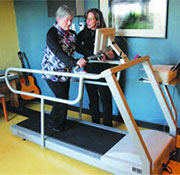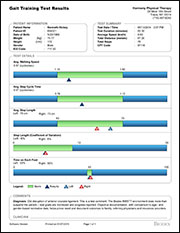Enhance resident care, attract more patients, strengthen partnerships and prove better outcomes… in less time.

Products
NEW Music Therapy: for the Gait Trainer™ 3
Sensory-Enhanced Treatment for Neuroplasticity
Music therapy is the use of music in rehabilitation and medical settings to improve functional movement, treating such conditions as:

Fit the music to the patient. Select the correct tempo (bpm) to accommodate patient's step cadence or steps per minute (spm)
- Parkinson's disease
- Multiple sclerosis
- Cerebral palsy
- Stroke
- Traumatic brain injury
- Ligament disorders
Treat More Patients with Music Therapy
The current ratio of Physical Therapists to Music Therapists is 30:1. The need is there. The increasing rate of Parkinson's diagnosis alone reinforces this point. Integrating music therapy with the Gait Trainer 3 becomes an efficient rehabilitation tool that enables the Music Therapist to treat more patients on a broader scale. The value of music therapy can now be measured - prove faster outcomes with documented, quantitative reporting.
The Biodex Gait Trainer 3 is an Ideal Platform for Integrating Music Therapy
Music tempo, or beats-per minute (bpm), can be managed to influence certain gait characteristics. Walking, or gait cycle time, can be described as steps-perminute (spm). Biodex Gait Trainer 3 has the capability to control belt speed (individual's walking speed) in units of spm (gait cycle time).

An Exercise Summary Report shows need, progress and outcome of the therapy
While the repetition of gait training addresses neuroplasticity, music therapyinformed compositions in the correct beats per minute (bpm) elicit the desired gait pattern. The Gait Trainer includes a starter library of compositions and enables music therapists to incorporate their own. Music can also be transferred to a patient's personal device to reinforce learning outside the clinical setting.
The Gait Trainer 3 provides real-time biofeedback and quantifiably displays step length, step cadence (spm) and step symmetry. With the Music Therapy option, the Gait Trainer 3 serves as a platform for rehabilitative collaboration.
How Music Therapy Impacts Physical Rehabilitation
The brain, when affected by debilitating neuropathologies, i.e. Parkinson's, Stroke, Cerebral Palsy, and TBI, will respond favorably to Rhythmic Auditory Stimulation (RAS) in the form of Music Therapy. RAS is sometimes referred to as Rhythmic Auditory Cueing (RAC). The response is neuroplasticity, the reorganization of neuropathways to relax and/or induce muscles for movement.
Fitting the music to the patient synchronizes gait for pattern sensory-enhanced movement. Walking can be aligned with Rhythmic Auditory Cueing (RAC) to improve temporal (velocity), special gait (stride length) and gait symmetry (left/right stride deviations). The qualitative component of what is done musically is quantified and documented by the system's computer. The pre-test, comparison to normative data, and post test results are presented in scientific data: the songs, beats per minute, the dates and progress are now part of the treatment conversation, giving music therapists a greater voice in the plan of care.
Related Applications:
Resources:
Biodex can give your facility The Referral Advantage™
ACCELERATED REHAB | IMPROVED OUTCOMES | REDUCED RISK OF READMISSIONS
To schedule an online presentation or for more information, Call 1-800-224-6339 or Email seniorrehab@biodex.com




 Biodex Medical Systems, Inc., 20 Ramsey Road, Shirley, NY 11967-4704
Biodex Medical Systems, Inc., 20 Ramsey Road, Shirley, NY 11967-4704